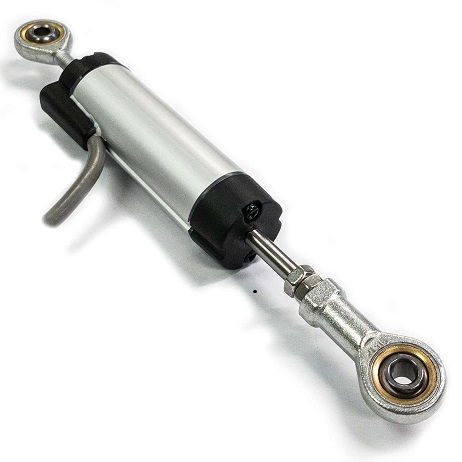The LPPS-22 Linear Potentiometer Position Sensor represents the pinnacle of precision measurement technology in industrial applications. Engineered with rod end joints for versatile installation, this sensor delivers accurate position feedback critical for automation systems, hydraulic equipment, and mechanical controls. Let's explore how this advanced sensor can elevate your operational efficiency and measurement precision.
Understanding Linear Potentiometer Technology
Linear potentiometers function as variable resistors that change electrical resistance based on the position of a slider or wiper along a fixed track. The LPPS-22 utilizes this principle to convert mechanical movement into electrical signals with exceptional accuracy and reliability.
How the LPPS-22 Sensor Works
At its core, the LPPS-22 contains a precision resistive element with a conductive wiper that moves along it. As the rod moves, the wiper's position changes, altering the resistance and creating a voltage output proportional to the position. This simple yet effective design provides:
- Real-time position feedback
- Continuous measurement capability
- Analog output for seamless integration
- Robust performance in challenging environments
Advantages of Rod End Joints
The integration of rod end joints in the LPPS-22 design represents a significant advancement in mounting versatility. These articulating connections:
- Allow for self-alignment during installation
- Compensate for misalignment in mechanical systems
- Reduce side loading on the sensor shaft
- Extend operational lifespan by minimizing mechanical stress
Technical Specifications and Performance
The LPPS-22 Linear Potentiometer Position Sensor is engineered to meet demanding industrial requirements while maintaining excellent measurement accuracy.
Key Technical Parameters
Parameter Specification Measuring Range Up to 750mm Linearity±0.1% Resolution Essentially infinite Operating Temperature-40°C to +100°C Protection Class IP65 Supply Voltage10-30 VDC Output Signal Analog voltage or current
Durability Features
The LPPS-22 is built to withstand harsh industrial environments with:
- Anodized aluminum housing for corrosion resistance
- High-grade internal components for extended durability
- Sealed construction for protection against dust and moisture
- Vibration-resistant design for reliable operation
- Temperature-compensated electronics for consistent performance
Applications and Industry Solutions
The versatility of the LPPS-22 Linear Potentiometer Position Sensor makes it suitable for numerous applications across various industries.
Manufacturing and Automation
Robotic Systems
In robotic applications, the LPPS-22 provides critical position feedback for precise movement control. The rod end joints allow for easy integration with moving parts while accommodating the dynamic movements typical in robotic systems.
CNC Machinery
Computer Numerical Control (CNC) machines benefit from the LPPS-22's high precision and reliability. The sensor helps maintain positioning accuracy crucial for quality manufacturing outputs.
Hydraulic and Pneumatic Systems
Cylinder Position Monitoring
The LPPS-22 excels in hydraulic cylinder position sensing, where the rod end joints facilitate installation directly onto cylinder mounts. This configuration provides:
- Direct measurement of stroke position
- Simple retrofit capability for existing systems
- Minimal modification requirements
- Improved system diagnostics
Valve Position Feedback
For valve automation systems, the LPPS-22 offers precise feedback on valve position, enabling advanced control algorithms and predictive maintenance capabilities.
Mobile Equipment and Transportation
Industrial vehicles and transportation systems utilize the LPPS-22 for:
- Outrigger position monitoring
- Lift height measurement
- Steering feedback systems
- Suspension travel monitoring
Test and Measurement Applications
The high accuracy and reliability of the LPPS-22 make it ideal for:
- Material testing machines
- Structural displacement monitoring
- Dynamic movement analysis
- Quality control systems
Installation and Integration Guidelines
Mounting Considerations
Proper installation of the LPPS-22 ensures optimal performance and longevity:
- Utilize the rod end joints to minimize side loading
- Ensure proper alignment with the measured movement
- Secure mounting points to prevent vibration transfer
- Allow for full range of motion without interference
- Consider environmental protection requirements
Electrical Connection and Calibration
Wiring Guidelines
The LPPS-22 features straightforward electrical connections:
- Power supply (10-30 VDC)
- Signal output (analog voltage or current)
- Ground connection
- Optional shield connection for noisy environments
Calibration Process
For maximum accuracy, follow these calibration steps:
- Install the sensor in its final position
- Move the mechanism to known reference points
- Measure output signals at these points
- Adjust system parameters to match physical positions
- Verify calibration across the full measurement range
Maintenance and Troubleshooting
Preventive Maintenance Recommendations
The LPPS-22 requires minimal maintenance, but regular checks ensure continued reliability:
- Inspect rod end joints for excessive wear
- Check electrical connections for corrosion or looseness
- Verify signal output accuracy periodically
- Clean exposed surfaces as needed
- Confirm proper movement throughout the stroke range
Common Issues and Solutions
Signal Fluctuations
Intermittent signals often indicate electrical interference or connection issues. Verify shielding and grounding connections.
Reduced Accuracy
A gradual loss of precision can often be traced to mechanical wear, misalignment, or contamination. Inspect the sensor for shaft or rod end wear, buildup of debris, or damage to mounting hardware, and verify proper alignment with the measured motion.
Environmental Factors
Temperature extremes or moisture ingress can affect performance. Ensure proper environmental protection meets application requirements.
Customization Options and Accessories
The LPPS-22 can be customized to meet specific application requirements:
- Custom stroke lengths for specialized applications
- Alternative mounting configurations
- Modified output signal ranges
- Special environmental protection options
- Integration with digital interfaces through signal conditioners
Conclusion: Why Choose the LPPS-22 Linear Potentiometer Position Sensor
The LPPS-22 Linear Potentiometer Position Sensor with rod end joints represents an ideal balance of precision, durability, and installation flexibility. Its robust design and reliable performance make it suitable for demanding industrial applications where accurate position feedback is critical.
By incorporating this sensor into your systems, you benefit from:
- Enhanced positioning accuracy
- Simplified installation through rod end joint flexibility
- Reduced maintenance requirements
- Extended service life under challenging conditions
- Improved system diagnostics and control capabilities
For engineers and system designers seeking reliable position feedback solutions, the LPPS-22 offers proven technology with the adaptability to meet diverse application requirements.
Ready to order or interested in more information?
Click the link below to see the LPPS-22 Product overview video.

